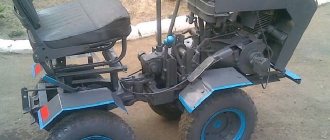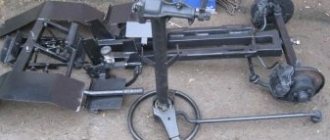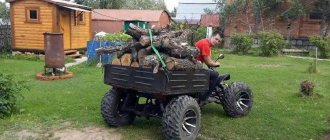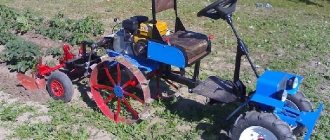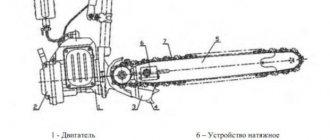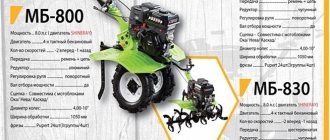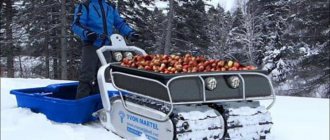Small mechanization tools for working on a personal plot are a technical area where there is always considerable demand. One of the most convenient and versatile devices for various agricultural and harvesting work is a walk-behind tractor. Today, buying a domestic or Chinese-made walk-behind tractor is not a problem; the range is very wide. However, in order not to overpay or, conversely, not to take a unit that is too weak, you need to pay enough attention to the choice.
Types of walk-behind tractors
A walk-behind tractor is a low-power engine that, through a transmission, drives wheels mounted on one axle.
For control, there are two handles with buttons and switches. The working position of the walk-behind tractor is when the operator follows it, holding the handles. Some devices provide the ability to install a trailer, which allows you to move on it like a cargo scooter with a front drive wheel.
Expert opinion
Kuznetsov Vasily Stepanovich
There are no clear differences between walk-behind tractors and walk-behind cultivators. Typically, a motor cultivator means a weaker device, on the axis of which cutters are mounted for digging (cultivating) the soil. The walk-behind tractor moves and stands on wheels, and the equipment is usually mounted or trailed. However, the ability to change wheels for cutters makes this border very arbitrary.
What attachments does the walk-behind tractor work with?
Any experienced farmer knows that with the help of a walk-behind tractor, cultivator or other motorized equipment, almost all agricultural work can be mechanized: starting with cultivating the land to prepare it for sowing and ending with transporting the harvested crop. Motor units have become universal due to the possibility of using a variety of attachments. In addition to moldboard and other plows, the following equipment has been created for processing plowed land and cultivating virgin lands:
Harrows are used to plow virgin soil, as well as for pre-sowing (spring) or post-harvest loosening (autumn) of arable soil to a depth of 7-14 cm. Using harrowing with a walk-behind tractor or cultivator, the surface is leveled, moisture is covered, and weeds are destroyed. The working parts of such agricultural implements are metal teeth or spherical disks. In this video you can clearly see how to properly plow with a walk-behind tractor and a homemade harrow. And also from there you can learn improvements for the harrow.
The hiller is used to hill up potatoes, cut furrows for sowing seeds, backfill planting material, and also sprinkle weeds directly in the row area. Hilling devices come in single-row and double-row, with fixed and adjustable working widths, distinguishable both by their design and their efficiency. Here is a video of how the Neva MB2 motor cultivator performs processing with a mounted two-row weeder-hiller.
With a rotary cutter you can plow virgin soil, carry out pre-sowing and basic cultivation of plowed land. This agricultural implement allows you to mill, cultivate the land and qualitatively prepare it for sowing. It is capable of not only plowing the soil, but also mixing it with fertilizer, crumbling large layers, crushing stubble particles, and leveling the sown area. Rotators for cultivation come in different types, depending on the number of cutting elements. This video shows how to actually plow a walk-behind tractor with a cutter installed on it, as well as cultivation.
A flat weeding cutter helps to trim weeds, split and cut grooves without turning the formation, plow and crush the soil. Flat cutters come in all possible working widths and processing depths, which allows you to choose them for specific processing conditions of agricultural plots and crops. This video demonstrates well how to carry out processing with a mounted flat cutter in practice (using the example of a Dnepr walk-behind tractor).
In addition to the listed removable tools designed to plow virgin soil and cultivate arable land, rakes, wood splitters, seeders, shredders, cultivators, rotary and segment mowers, shovels, sprayers, sweeping brushes, snow blowers, etc. are used with the motorized unit. Having a basic set of mounted agricultural implements, you can use a walk-behind tractor or a powerful cultivator to perform all kinds of economic tasks, in particular, pre-sowing plowing, sowing and planting crops, applying fertilizers, inter-row cultivation of crops, harvesting root crops, and seasonal harvesting of green fodder.
About the engine
The gasoline engine has been used in walk-behind tractors from the very beginning of their introduction as small-scale mechanization machines. For a long time it was a two-stroke engine, since it was this type that provided greater power and unpretentiousness, and then they did not pay attention to increased noise and exhaust. Today, most devices are equipped with four-stroke engines - they are quieter, have a longer service life, and also use fuel more economically. Almost all devices have one cylinder. Only the heaviest walk-behind tractors are equipped with two-cylinder engines, which makes them closer to mini-tractors.
Transmission type
Torque from the engine to the drive axles can be transmitted using various types of gears:
. The most common type of transmission. The engine crankshaft in such models is usually located parallel to the axis of the wheels. To transmit torque, pulleys with a belt or a pair of sprockets with a chain are used. Sometimes the belt drive functions as a V-belt variator - this unit usually reduces the rotation speed, but increases traction capabilities. Sometimes a double pulley is installed instead of a power take-off shaft.
Belt and chain- Toothed-worm . This transmission is very light and compact, usually installed on weak walk-behind tractors intended for use in private households. The crankshaft in them is located vertically, the clutch is usually automatic centrifugal.
- Serrated . This is a classic type that is usually used on full-size equipment such as tractors. The transmission is reliable, but heavy and resource-intensive, and costs a lot. Therefore, they put it on heavy row-crop walk-behind tractors, which are advisable to use over a large area.
The country where walk-behind tractors are the most popular as a type of equipment is China. There are a lot of private peasant farms there, but there is no money for a mini-tractor. But in the USA, on the contrary, walk-behind tractors are not used at all - because there are no farms there at all, and professional farmers use tractors. Russia is approximately in the middle: the walk-behind tractor here is used by owners of private land plots, who sell the surplus to harvesters.
Vehicle class
The class of a walk-behind tractor means its focus on a particular type of work, design and operation features.
This includes weight, engine power, and the ability to work with various attachments. Conventionally, all walk-behind tractors are divided into light, medium and heavy. The “heavier” the equipment (often literally), the better suited it is for large volumes of complex work. The characteristics of attachments and trailers, for example, cutters or plows for plowing or weeding, also depend on the class.
Today, many people have money, and the market offers many options. Sometimes inexperienced site owners, instead of taking a light and simple 4-5 liter walk-behind tractor. with., which will mainly cultivate soil on 10 - 20 acres, they take instead a device that is three times heavier and twice as powerful - “in reserve.” It must be remembered that the heavier the walk-behind tractor, the more difficult it is to work with it. Equipment should be taken for real, specific needs.
How to plow properly with a walk-behind tractor: plowing land, working with different attachments
A multifunctional walk-behind tractor can perform a wide range of work in the field, cottage and garden. In order to quickly and efficiently process arable land and virgin soil, various types of attachments are used together with the device. The most common and best tillage unit is the share plow. Instructions on how to prepare it for work and plow it correctly are described in our article.
Parameters that optimize performance
In order for the walk-behind tractor to be as functional as possible, it is equipped with various systems and devices. Of course, such improvements cannot be an end in themselves - a simple but reliable walk-behind tractor with one gear and no reverse is better than a unit packed with functions, but which is not taken into service under warranty.
What gear is on your petrol walk-behind tractor?
ToothedBelt
Number of speeds
In simple devices, the speed is generally the same - it is cheaper, simpler and weighs less. More advanced walk-behind tractors may have 2 - 4 speeds. This is especially convenient when driving with a trailer. Also, all heavy and many medium-sized units have a reverse function, that is, reverse.
Availability of power take-off shaft
This element allows you to transmit engine torque to trailed and mounted equipment: plows, potato diggers, seeders, threshers, wood splitters, snow blowers and many others. In addition to the PTO itself, which looks like a rod with a groove and a key or other interlocking locking device, the transmission to the attachments can be a belt - it is usually used for the type of equipment that is attached to the front of the walk-behind tractor.
Best small class model
A lightweight walk-behind tractor is a wonderful unit that will come to the aid of a summer resident or businessman who owns a small plot. The versatility of the device is an absolute plus here, because with its help it will then be possible to perform many different operations.
Mobile K MKM-3 PRO MBK0018441 6.5 hp
Characteristics:
- class: light;
- maximum processing width 105 cm;
- speeds: 2 forward, 1 reverse;
- engine: Loncin G200FA;
- gearbox type: gear-chain;
- wheel type: cast rubber;
- weight: 69 kg.
Despite its rather modest size and weight, this device, produced in the city of Gagarin, is distinguished by considerable power, as well as a processing width of more than a meter.
With its help, you can not only weed between rows and plow the ground, but also dig up potatoes, pump up water or mow the grass.
It is also possible to attach a trailer. Cast wheels - on the one hand, this is less practical and adds weight, on the other hand, it allows you not to bother with tire pressure and the selection of internal tubes. A gear-chain mechanism cannot be called cheap, but it is still cheaper than a gear mechanism. The reliability of the unit is characterized as high.
| pros | Minuses |
| Possibility of configuration with different engines | Alloy wheels |
| Versatility of use | High price |
| Reliable performance |
Review
| Artyom Sokolovsky, 64 years old, Samara region: |
| I bought such a device for my farm. The plot is small, so initially I was looking for a light walk-behind tractor. This one is simply excellent: unlike Chinese cars, it is a full-fledged walk-behind tractor: a huge number of attachments can be connected to it, and, of course, I made a trailer. True, the price is considerable, but it justifies itself. |
Electric cultivator: rating of the best models of 2020
Daewoo Power DAT 2000E
A small 2-kilowatt cultivator for cultivating a summer cottage or garden plot. It has a worm gear (on Yandex Market it is mistakenly indicated as a “chain”) gearbox, which allows you to plow a garden that is regularly monitored. Of course, it won’t take virgin soil with thick grass, but that’s not what it’s designed for. The plowing width here is 40 cm and the depth is 23 cm. This is quite enough to prepare the soil for planting useful crops.
The set includes 6 cutters with a total of 24 knives. The rotation speed of the cutters is 360 rpm, and there is only one speed and only forward. Although you can’t turn it back here, given its light weight of 12 kg, the device can easily be deployed on the spot. All shortcomings are compensated by the low price of the device.
Elitech KB 4E
An excellent electric cultivator for small vegetable gardens, greenhouses, greenhouses and personal plots. A 2 kW motor is installed here, which rotates 4 steel cutters. The working width here is already 45 cm, so the speed of processing the area as a whole is slightly faster than that of the model from Daewoo. True, the processing depth is relatively low, 15 cm.
A nice feature is the presence of a chain gearbox, which allows the device to cope with serious loads. You can even plow trampled soil. Although the manufacturer positions the unit as lightweight, its weight is 32 kg, which is suitable for a man, but will be difficult for a woman.
Hyundai T 2000E
The well-known South Korean company produces not only high-quality cars, but also good garden equipment, and the T 2000E model is a prime example of this. The cultivator is equipped with a 2 kW motor. It rotates 4 cutters with a width of 45 cm and a diameter of 28 cm. However, the cutter does not go completely into the ground, so the working depth is 26 cm. The working tool has two protective metal disks on the sides that protect plants from getting into the cutter. Thanks to this, you can easily cultivate the soil in close proximity to the plants.
For better “driving,” the device is equipped with a transport wheel mounted on the front panel of the cultivator. The control handle can be adjusted in height to suit your needs. You can note the quality and reliability of the device's assembly. True, the components themselves are expensive, so repairs will be expensive.
Best middle option
Medium walk-behind tractors are designed for a wide range of work. Using them to dig up the ground with a cutter on axes will no longer work - the weight is too much. But the productivity with trailed equipment will be greater, and the depth and width of processing will increase.
CHAMPION BC9713 7 HP
Characteristics:
- class: middle;
- cultivation depth 30 cm;
- maximum processing width 80 cm;
- gearbox: manual;
- speeds: 2 forward, 1 reverse;
- engine: Champion G210-1HK;
- gearbox type: gear;
- reverse;
- PTO;
- wheel type: pneumatic;
- weight: 98 kg.
An honest Chinese walk-behind tractor that doesn’t pretend to be advanced, but its price is quite reasonable. It is equipped with a self-made engine (as you know, Champion gasoline vehicles are produced at full-cycle parent factories).
Power 7 liters. With. quite enough for working on a medium-sized plot. Despite the fairly substantial weight of almost 100 kg, when plowing the walk-behind tractor sometimes begins to bounce, which can be solved by adding weights. Pneumatic wheels and a reliable gear drive bring it closer to professional models.
| pros | Minuses |
| Good build | Small plowing width |
| Low price | |
| Gear transmission |
Review
| Mikhail Varvarin, 46 years old, Voronezh region: |
| An excellent walk-behind tractor for a reasonable price. I liked it better than the Russian ones. The Russian manufacturer will not set the price for himself. Apparently, it’s expensive to produce here. And the Chinese have such volumes that they can keep the price low. Everything you need to eat. I tied a bag of cement in front, “harnessed” it to the cart and drove off. He transported loads of firewood on it, and all the outbuildings were brick by brick. |
The best heavy machine
Heavy equipment is successfully used in areas where light and weak devices cannot cope. The design features, materials and mechanisms of such units allow them to be not only functional, but also reliable.
GRASSHOPPER 188F 13.05 HP
Characteristics:
- class: heavy;
- gearbox: manual;
- speeds: 4 forward, 2 reverse;
- engine: WEIMA 188F;
- gearbox type: gear;
- reverse;
- PTO;
- wheel type: pneumatic;
- weight: 217 kg.
Belarusian assembly from foreign components - we can say that this is premium-class Belarus. The Weima engine, a Chinese licensed copy of the Honda engine, is used as the “heart” of the device. The weight of the device is 217 kg, which allows it to work successfully even on virgin soil.
The gear transmission and take-off shaft make it possible to work with almost any mounted and trailed equipment. A trailer can carry a significant amount of cargo, especially if the walk-behind tractor itself is made heavier for better traction. Thanks to two normal and two reduced speeds, the speed is quite acceptable - 16 km/h.
| pros | Minuses |
| Great power | High price |
| Solid weight | |
| Good gearbox |
Review
| Maxim Leonidov, 41 years old, Stavropol: |
| I can’t call myself a farmer, the volumes are not the same, but I sell some of my vegetable production regularly. I sell meat myself - I have cows and pigs on my farm. Potatoes are the most common vegetable. Recently, with this walk-behind tractor, I plowed a plot for potatoes, which had previously been overgrown with grass - and nothing, it did an excellent job. The fact that it’s heavy is good, it doesn’t jump at all. |
What is the difference between a motor cultivator and a walk-behind tractor?
| Motor cultivators | Walk-behind tractors | |||||||
| Weight, kg | 20 — 60 | 70 — 120 | ||||||
| Power l. With. | 3 — 6 | 7 – 12 or more | ||||||
| Frame design | The rigidity and massiveness of the frame depends on the power. | Massive, reinforced frame. | ||||||
| Transmission | Limited to one gear, it is possible to set the direction of rotation of the cutters. | There is a gearbox, at least 2 forward and 1 reverse gear. | ||||||
| PTO | ||||||||
| Pneumatic tires | Only some models are equipped with pneumatic tires. | As a rule, they are equipped with pneumatic wheels. | ||||||
| Milling | The main method of tillage. | Can be used, but is not the main method of processing. | ||||||
| Working with hillers | Heavy models will be able to work, but only on light soils. | Can work with double hillers. | ||||||
| Working with a plow | Not adapted. | Can handle various types of soil. | ||||||
| Working with a potato digger | Not adapted | Can work with a potato digger. | ||||||
| Operating a mower, snow blower or other active implement | Not adapted. | Models equipped with a power take-off shaft can operate. | ||||||
| Transport work | It is possible to adapt it for transport work, but it is not practical. | It is possible to carry out transport work. | ||||||
Motor cultivators
Very popular cars based primarily on gasoline engines. The motor power is 3 - 6 hp, and the weight of the unit reaches 60 kg. The range of weights is quite significant - you can find cultivators weighing about 20 kg, and you can also buy models that provide for the installation of special ballast weights, increasing the total weight to 100 kilograms or more. This is required when working on heavy soils and performing certain operations, which will be discussed below.
The functionality of motorized cultivators is quite limited - fluffing up the soil, weeding, inter-row cultivation, and in some cases, hilling. The scope of use of motor cultivators weighing up to 50 kg is country and personal plots of up to 15 - 20 acres, flower beds, greenhouses.
The working body of the motor cultivator is a sectional rotating cutter with a width of 35–70 cm. Due to the removable sections, the width of the cutter can be changed, which is very convenient for processing different crops with different row spacings. The cutter is at the same time the mover of the unit - hooking onto the ground, it pulls the cultivator forward at a speed that is regulated by the gas handle.
Modern models of motor cultivators can be equipped with CVT or gear type gearboxes with or without reverse. As a rule, gearboxes are installed on devices heavier than 50 kg. The number of gears for most models is not too large - 1+1 or 2+1.
Instead of a cutter, metal wheels with lugs can be installed on heavy models. This makes it possible to use trailed implements - plows and hillers. But practice shows that even heavy motor cultivators are not able to cope with plowing, and hill up potatoes at an acceptable level of quality only on light soils, even if the rows are pre-treated with a milling cutter.
Summarizing the information, we can say with all confidence that motorized cultivators have the right to life, and even have their own advantages over walk-behind tractors, but only if they are used in small areas and inside artificial structures. The main operations that most motor cultivators cope with “excellently” are loosening the soil with a milling cutter and cultivating row spacing.
Walk-behind tractors
In a debate about whether a motor-cultivator or a walk-behind tractor is better, one cannot clearly take one side or the other. This is approximately the same as comparing a caterpillar tractor and a passenger car. Each of the units has its own purpose and its own characteristics. If we compare identical operations, a walk-behind tractor copes with them more confidently than a motor-cultivator, but in return it is more expensive, heavier, and consumes more fuel.
Walk-behind tractors are produced based on gasoline and diesel engines in approximately equal proportions. Gasoline engines are installed on light and medium-sized walk-behind tractors, weighing 50 - 150 kg, diesel engines - on a significant part of medium and heavy ones, the weight of which can reach 300 kg. The engine power of light walk-behind tractors is about 6 hp, medium - up to 8 hp. and heavy ones - 8 - 12, or even more horsepower.
The main difference between a walk-behind tractor and a motor-cultivator is the presence of pneumatic tires and a power take-off shaft, which allows you to connect a wide train of attachments - the same cutter, mower, pump, wood splitter, etc. Pneumatic wheels are used in both transport and working positions.
Walk-behind tractors of all types are equipped with full-fledged gearboxes with mandatory reverse speed. Medium and heavy walk-behind tractors can have up to 4–5 forward and 2 reverse gears. But most models have simpler transmissions with 2–3 forward and one reverse gears.
The engine is started either manually or using an electric starter (for some professional-class models). Walk-behind tractors work reliably with almost all types of agricultural implements. They can plow, cultivate, mow, dig potatoes. It is very convenient to use them as a vehicle - most of the walk-behind tractors are equipped with trailed trolleys with a carrying capacity of 0.3 - 1 ton. The speed of a walk-behind tractor with a trailer can exceed 12 km/h.
Medium and heavy versions of walk-behind tractors are equipped with a locking differential, which allows you to work on heavy soils, wet grass and move along washed-out roads and arable land.
There are also transitional models on the market, which in their basic parameters are similar to a walk-behind tractor and have a lot of weight, a gearbox, a gearbox, but do not have a power take-off shaft. Essentially, this is a motor-cultivator on wheels, and it is often difficult to understand the difference between a motor-cultivator and a walk-behind tractor. These are intermediate models that have absorbed all the best from both cars.

